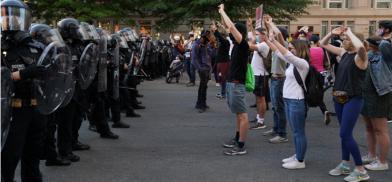Is America’s middle class more sensitive than India’s?
What racism is in the world’s oldest democracy, communalism unfortunately is in its largest version in India. It is no secret that sizeable sections of India’s largest community, the Hindus, are communal, writes Amulya Ganguli for South Asia Monitor

Television viewers have seen how thousands of Americans, mostly middle class, comprising whites, blacks, Asians and Latinos have come out on the streets to protest against a single act of police brutality which took the life of a black man. The killer has been arrested and his three companions dismissed from service and may face arrest on the grounds of being “complicit”, as the Minneapolis police chief said, for not intervening when the black man’s life was being sadistcally snuffed out. If anything shows America’s status as a democracy to be higher than that of India, it is this incident. It underlines the fact that even if there are a few “bad apples” in the police force, as the US National Security Adviser, Robert O’Brien, has said, racism is not institutionalized in anyway among the uniformed personnel.
What racism is in the world’s oldest democracy, communalism unfortunately is in its largest version in India. It is no secret that sizeable sections of India’s largest community, the Hindus, are communal, as the former chief justice of India, Markandey Katju, has pointed out. Sectarianism may prevail among Muslims, Sikhs, Jains, Buddhists, Parsis and others, but it does not matter all that much because of their far smaller numbers. As such, they do not threaten to undermine India’s pluralism. But the Hindus potentially do because of their numerical and political power.
It is a worrying sign, therefore, that in almost every middle-class Hindu family, there is at least one Islamophobic individual who agrees with the Rashtriya Swayamsevak Sangh (RSS)-led Sangh Parivar's worldview that the Muslims are a menace. According to this outlook, from the time of their entry into the subcontinent in the 8th century, the Muslims have posed a near-existential threat to the nation’s culture and integrity. Moreover, they have partly succeeded in their nefarious designs by breaking up the country in 1947 and posing the threat of further divisions by breeding exponentially with their many wives.
BJP and Muslims
Thus runs the Parivar’s horror story which was last articulated by a Bharatiya Janata Party (BJP) MP during the protests led by Muslim women against the citizenship laws in New Delhi’s Shaheen Bagh Muslim-dominated neighbourhood when he said that the community’s menfolk will rape and kill Hindu women if the agitation continued. It could lead to another Mughal raj, said another In parliament. More recently, the principal of a medical college in Kanpur has described Muslims as terrorists who should be in jail instead of being treated for Covid-19 in hospitals. This tactic of arousing fear and anger against the Muslims is the BJP’s electoral trump card.
However, the white Republicans in the US are not very different. According to the Pew Research Centre, only 15 percent of the Republicans think that the US hasn’t gone far enough to give blacks equal rights with the whites against 64 percent of the white Democrats. On the other hand, 31 percent of the Republicans believe that it has gone too far against five percent of the Democrats. The difference, however, between India and the US is that the two parties are almost evenly matched in the US while the political scene is tilted in the BJP’s favour at present in India. Since the latter’s support base comprises mainly the Hindu middle class, it is this group that loudly articulates the saffron line as can be seen from some of the Hindi and English TV channels which act virtually as the BJP’s mouthpiece. Moreover, considering that the BJP’s anti-Muslim politics reflects the middle class’s inherent bias, the two together constitute a formidable driving force in India.
Conflicting attitudes
This isn’t the case in the US where there is an attempt, even by Republicans (Donald Trump claims that there is not “a single racist bone” in his body), to bridge the gulf between whites and blacks although the Republicans are aware of the value of white supremacism which is their electoral bread and butter. In India, too, the BJP occasionally tries to reach out to the Muslims. Modi’s “sabka saath, sabka vikas, sabka vishwas” (for all, development for all, trust of all) mantra is one such endeavour as is the Union minority minister, Mukhtar Abbas Naqvi’s claim that India is a “heaven” for Muslims. But these gestures are overshadowed by the frequent diatribes by other BJP leaders and followers against the Muslims and the act of garlanding a lynch mob by a former Union minister.
The police, too, appear leaden-footed in preventing or apprehending the lynch mobs and have recently been accused by the Delhi high court of a “targeted” approach directed against Muslims in investigating the communal riots in the national capital earlier in the year. The most infamous incident of such targeting was in the aftermath of the 2002 Gujarat riots when the police closed hundreds of cases on the grounds of lack of evidence as a result of which some of them had to be tried outside Gujarat, leading to convictions of the rioters and relief for the victims.
It was during this period that sections of the Hindu middle class could be heard supporting the police action in Gujarat on the grounds that the Muslims deserved it. Historian Tapan Ray Chaudhury was shocked to hear such views in the supposedly Left-minded and “intellectual” city of Kolkata. Does this mean that the Indian middle class is less sensitive about civil liberties than its American counterpart?
(The writer is a current affairs analyst. The views expressed are personal and not necessarily shared by editors of South Asia Monitor)









Post a Comment